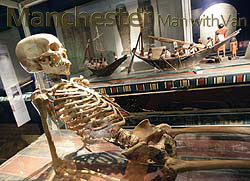The Manchester Museum is located on Oxford Road in the heart of a group of neo-Gothic buildings that belongs to the University of Manchester. The museum has a collection of approximately 4.5 items which origin from every continent on the planet. The Manchester Museum is the largest university museum in the United Kingdom and serves both the purpose of a touristy attraction and an academic research and teaching centre. According to the latest number the museum has approximately 360.000 visitors per year.
 The collection of the museum is displays in 14 separate sections which are:
The collection of the museum is displays in 14 separate sections which are:
- Anthropology – The anthropological collection of the museum is comprises of about 16.000 items, half of which are from Africa.
- Archaeology – This section of the museum is divided into four smaller sub-sections which are Western Europe, Egypt, Western Asia and Mediterranean. Many consider the Worsely Man a bog body to be the focal relics of the archaeology section of the museum.
- Archery – In this section of the museum visitors can see approximately 2.000 relics which are related to the evolution of archery throughout the years. A large part of the relics was donated to the museum by Ingo Simon in 1946.
- Botany – This section is also known as the Manchester Herbarium and has a total of 950.000 specimens which date back to the 18th, 19th and 20th century and come from all over the world.
- Earth sciences – The geological collection of the museum is comprised of 9.000 mineralogical specimens and is considered to be a collection with extreme local importance.
- Entomology – This section of the museum has the largest collection with approximately three million items.
- Numismatics – The museum started to display coins and medals made from various materials in 1895 when businessman Reuben Spencer donated the first coins to the museum.
- Mammals – The collection comprises of several thousands of mammal specimens. The collection includes mounted mammals such as a Lowland Gorilla, an Aye Aye, and a Red Panda.
- Birds – The birds section of the museum has about 15.000 bird skins which come from than 2.000 bird species. Most of the skins were collection between 1850 and 1950.
- Corals – Most of the items in this collection came from coral specialist Sydney Hickson.
- Bryozoa – In this section is displayed the bryozoa collection of naturalist Arthur Waters.
- Molluscs – The Manchester Museum has the fourth largest mollusk collection in the United Kingdom with a total of 166.000 lots.
- Spirit – This collection includes 5.000 spirit specimens from the 19th and early 20th
- Microscope slides – The section of the museum showcases a large collection of slides including the renowned foraminifera collection of Frederick Pearcey.
The Manchester Museum is a must visit museum, so make sure that you visit it once you relocate to the city. You can ease your relocation by using professional man and van services. You can easily find such services as there are numerous man and van companies in Manchester that provide moving services.
Make sure that you spare at least a day for your visitation of the Manchester Museum as you will need it.